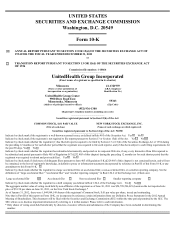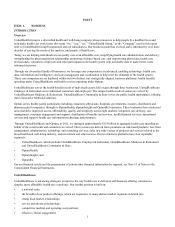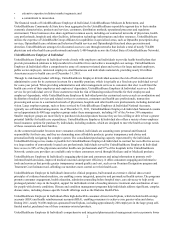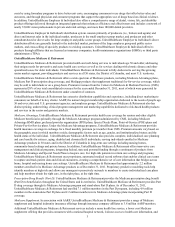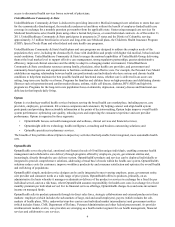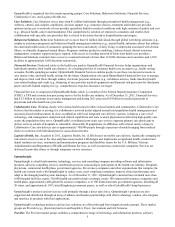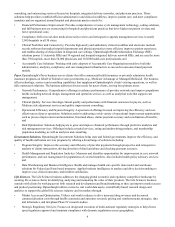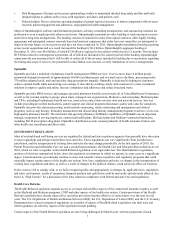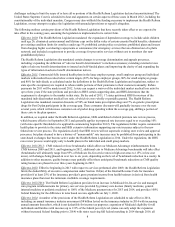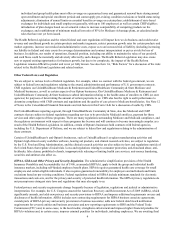United Healthcare 2011 Annual Report Download - page 6
Download and view the complete annual report
Please find page 6 of the 2011 United Healthcare annual report below. You can navigate through the pages in the report by either clicking on the pages listed below, or by using the keyword search tool below to find specific information within the annual report.4
access to discounted health services from a network of physicians.
UnitedHealthcare Community & State
UnitedHealthcare Community & State is dedicated to providing innovative Medicaid managed care solutions to states that care
for the economically disadvantaged, the medically underserved and those without the benefit of employer-funded health care
coverage in exchange for a monthly premium per member from the applicable state. States using managed care services for
Medicaid beneficiaries select health plans using either a formal bid process, or award individual contracts. As of December 31,
2011, UnitedHealthcare Community & State participates in programs in 23 states and the District of Columbia, serving
approximately 3.5 million beneficiaries of acute and long-term care Medicaid plans, the Children's Health Insurance Program
(CHIP), Special Needs Plans and other federal and state health care programs.
UnitedHealthcare Community & State's health plans and care programs are designed to address the complex needs of the
populations they serve, including the chronically ill, those with disabilities and people with higher risk medical, behavioral and
social conditions. UnitedHealthcare Community & State leverages the national capabilities of UnitedHealth Group, delivering
them at the local market level to support effective care management, strong regulatory partnerships, greater administrative
efficiency, improved clinical outcomes and the ability to adapt to a changing market environment. UnitedHealthcare
Community & State coordinates resources among family, physicians, other health care providers, and government and
community-based agencies and organizations to facilitate continuous and effective care. For example, the Personal Care Model
establishes an ongoing relationship between health care professionals and individuals who have serious and chronic health
conditions to help them maintain the best possible health and functional status, whether care is delivered in an acute care
setting, long-term care facility or at home. Programs for families and children focus on high-prevalence and debilitating chronic
illnesses such as hypertension and cardiovascular disease, asthma, sickle cell disease, diabetes, HIV/AIDS and high-risk
pregnancies. Programs for the long-term care population focus on dementia, depression, coronary disease and functional-use
deficiencies that impede daily living.
Optum
Optum is a technology-enabled health services business serving the broad health care marketplace, including payers, care
providers, employers, government, life sciences companies and consumers. By helping connect and align health system
participants and providing them actionable information at the points of decision-making, Optum helps improve overall health
system performance: optimizing care quality, reducing costs and improving the consumer experience and care provider
performance. Optum is organized in three segments:
• OptumHealth focuses on health management and wellness, clinical services and financial services;
• OptumInsight delivers technology, health intelligence, consulting and business outsourcing solutions; and
• OptumRx specializes in pharmacy services.
The breadth of this portfolio allows Optum to impact key activities that help enable better integrated, more sustainable health
care.
OptumHealth
OptumHealth serves the physical, emotional and financial needs of 60 million unique individuals, enabling consumer health
management and collaborative care delivery through programs offered by employers, payers, government entities and,
increasingly, directly through the care delivery system. OptumHealth's products and services can be deployed individually or
integrated to provide comprehensive solutions, addressing a broad base of needs within the health care system. OptumHealth's
solutions reduce costs for customers, improve workforce productivity and consumer satisfaction and optimize the overall health
and well-being of populations.
OptumHealth's simple, modular service designs can be easily integrated to meet varying employer, payer, government entity,
care provider and consumer needs at a wide range of price points. OptumHealth offers its products, primarily, on an
administrative fee basis whereby it manages or administers delivery of the product or services in exchange for a fixed fee per
individual served, and on a risk basis, where OptumHealth assumes responsibility for health care costs in exchange for a fixed
monthly premium per individual served. For its financial services offerings, OptumHealth charges fees and earns investment
income on managed funds.
OptumHealth sells its products primarily through its direct sales force, strategic collaborations and external producers in three
markets: employers (which includes the sub-markets of large, mid and small employers), payers (which includes the sub-
markets of health plans, TPAs, underwriter/stop-loss carriers and individual market intermediaries) and government entities
(which includes States, CMS, Department of Defense, Veterans Administration and other federal procurement). As provider
reimbursement models evolve, care providers are emerging as a fourth market segment for our health management, financial
services and collaborative care services.

